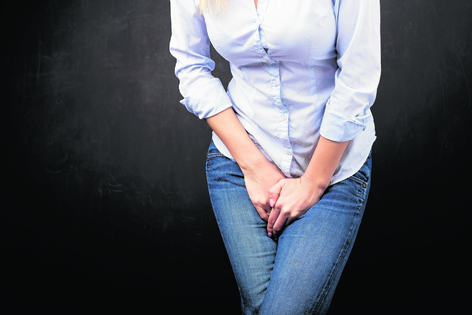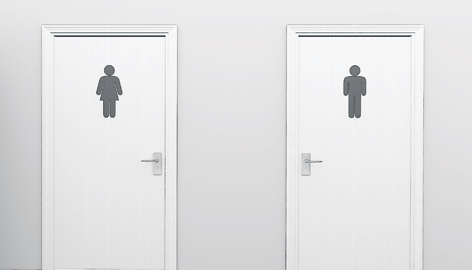The urge to rush to the toilet all the time can be annoying, inconvenient and even embarrassing – and also painful, if you have cystitis.
Usually caused by urinary tract infections, cystitis means inflammation of the bladder. Anyone, including children, can get it, though women tend to be far more prone to cystitis than men – believed to be due to anatomical differences, including a shorter urethra (the tube that carries urine from the bladder) and the fact the urethra opening is closer to the back passage, both of which mean bacteria can get to the bladder more easily.
FEEL THE BURN
As well as a constant urge to pee, the main symptoms are a painful, burning or stinging sensation when urinating, dark, cloudy or smelly urine, pain in the lower abdomen, and generally feeling unwell.
Susannah Fraser, spokeswoman for the Cystitis & Overactive Bladder Foundation (COB Foundation; www.cobfoundation.org) says: “Cystitis is a common problem, and while it can go within a few days, it’s normally very painful and people will often go to the doctor for antibiotics to help clear it up.
“It can make you feel nauseous and shivery and give you a high temperature. It’s an infection of the body, and in elderly people it can even give rise to dementia-type symptoms.”
Antibiotics aren’t required for every urinary tract infection, but it’s important to see your GP if you’re suffering chronic infections, symptoms don’t clear up or are very severe – especially if you have blood in your urine, if you’re pregnant, or if a man or child has symptoms.
If left untreated, in severe cases, cystitis can lead to more serious kidney infections, plus symptoms could also be a sign of other problems that need to be checked out.
Ensuring you wipe from front to back after bowel movements, not wearing thongs, and drinking plenty of fluids can all help keep urinary tract infections at bay.
CHRONIC CONCERN
Most women only experience cystitis once or twice in their lives, and thankfully it’ll be easily treated with antibiotics. However for others, the problem can be more chronic, whether that’s frequent infections, or a condition called interstitial cystitis, or bladder pain syndrome (BPS).
With this type of cystitis, there’s no obvious infection, antibiotics don’t work, and as well as the usual symptoms, there’s intense pelvic pain.
It’s a long-term condition with no known cure, and while the exact cause isn’t clear, one theory is that it may be linked to a defect or failure in the bladder’s protective glycosaminoglycan (GAG) layer, which increases bladder wall permeability and allows toxic substances through, leading to chronic inflammation.
Other theories include pelvic floor muscle problems, the immune system mistakenly attacking the bladder, or even that it’s an allergic reaction.
One thing’s for sure: it can be very difficult to live with.
“Interstitial cystitis is horrible, it can be very painful and really very miserable,” says consultant urological surgeon Mr Jonathan Goddard, who works at Leicester General Hospital. “It is still said to be rare, but as it is increasingly being seen in medical studies, it may not be as rare as we thought.”
COMPLEX CONDITION
Interstitial cystitis sometimes occurs alongside other medical problems, including irritable bowel syndrome, fibromyalgia, chronic fatigue syndrome, vulvodynia (chronic pain around the vagina opening), recurrent urinary tract infections and depression.
Mr Goddard says any treatment should target the related conditions as well as the bladder. “Patients often have associated conditions, and the bladder mucosa may not necessarily be the primary source of their pain,” he notes.
Treatment for interstitial cystitis is much more complex, and may include psychological support and antidepressants, as many people also experience anxiety, stress, depression and sleep problems.
Antihistamines, painkillers and anti-inflammatory drugs, plus GAG layer replacement therapy using drugs or physical therapy, may also be considered.
Lifestyle changes can also play a big role in managing the condition, including stopping smoking and making necessary dietary changes.
“Avoidance of food that worsens painful bladder syndrome is a basic, and often overlooked, management technique,” says Mr Goddard. “The list of possible exacerbating foodstuffs is exhaustive and different for each individual; however common culprits are caffeine, alcohol, spices and acid, including fruit juices.”
MOSTLY WOMEN
Fraser says there are thought to be around 400,000 people in the UK with interstitial cystitis, and 90% of them are women.
“The pain from interstitial cystitis is terrible; it really is extremely debilitating,” she says. “More research is desperately needed to stop the suffering, but because people often aren’t aware of this condition and the utter misery and despair it brings, there’s very little money available for research.
“So nobody understands why it occurs, and if you get it, you’re stuck with it.”
For more information and advice about cystitis or BPS, contact the COB Foundation advice line on 0121 702 0820 or visit www.cobfoundation.org

